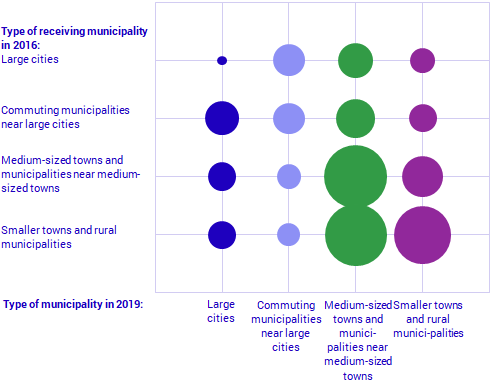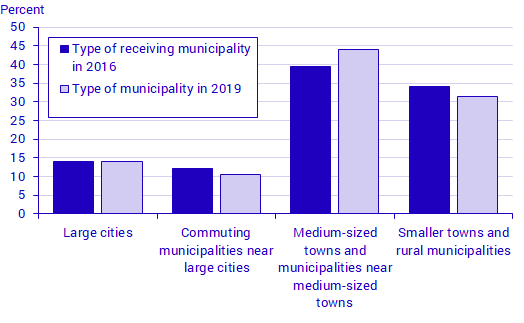Internal migration among newly arrived refugees during their first years in Sweden
Two in three newly arrived refugees still live in the same municipality three years after coming to Sweden
Statistical news from Statistics Sweden 2020-10-15 9.30
Almost one in three refugees and their families received by a municipality in 2016 relocated to another municipality within three years. Persons allocated to a medium-sized town stayed in that municipality to a high degree, and people also typically relocated to medium-sized towns.
The new report Internal migration among newly arrived refugees (“Så flyttar nyanlända flyktingar under de första åren i Sverige”) provides a picture of newly arrived refugees and their families who are received by a municipality, and their migration patterns during their first years in Sweden.
More common to remain in a medium-sized town
Among the roughly 70 000 persons received by a municipality in 2016, 68 percent were still living in the same municipality at the end of 2019. There are some differences among various groups. For example, the proportion of persons who stayed in the same municipality is higher among women than among men, and higher among cohabiting persons and children than among people living alone.
Persons received by a municipality can choose to arrange their own housing or to be allocated to a designated municipality via the Swedish Migration Agency. The designated municipality is obliged to arrange accommodation. Among persons received by a municipality in 2016, there were no major differences in migration patterns between persons who arranged their own housing and those who were allocated housing.
The most pronounced difference is noted in the type of municipality in which newly arrived refugees and their families were received. Among persons received in large cities, such as Norrköping, Helsingborg, and Östersund, 82 percent remained in the same municipality, compared with 50 percent of those received by a municipality near a large city.
Relocation to the same type of municipality is common
Many of the persons received by a municipality in 2016 who have migrated internally, did so to the same type of municipality in which they first settled. This was particularly the case for those who relocated from medium-sized towns, among whom just over 50 percent relocated to a municipality of the same type. The figure below shows relocations from the receiving municipality, by type of municipality, and the type of municipality at the destination. The size of the circles in the figure represents the number of persons who relocated between each type of municipality. Most people, around 3 600, relocated within the group “medium-sized towns” and from “smaller towns” to “medium-sized towns”, while the smallest number of people, around 80, relocated from one large city to another.

The migration typically occurred over relatively short distances. For instance, relocations within the group “medium-sized towns” often involved moving from a neighbouring municipality to a large city. The same pattern is present for persons who moved from municipalities near large cities, who often moved to another similar municipality or to a large city.
Migration flows toward large cities
Among persons who moved to another municipality, 46 percent settled in a medium-sized town, 28 percent settled in smaller towns, 14 percent settled in a municipality near a large city, and 12 percent settled in a metropolitan municipality.
This internal migration led to a larger proportion of newly arrived refugees living in large cities, and a decrease in the proportion of those living in smaller towns and metropolitan areas.

Definitions and explanations
Persons received by a municipality for settlement refers to persons who were granted a residence permit as a refugee or as a person granted subsidiary protection, according to certain provisions in the Aliens Act (2005:716), and their families, and who are covered by the Ordinance on state compensation for measures for certain aliens (2010:1122).
Municipalities are grouped according to the Swedish Association of Local Authorities and Regions’ 2017 municipal group classification based on criteria such as urban area size, proximity to major urban area, and commuting pattern.
Publication
Next publishing will be
On 20 November, the Statistical Database will be updated with statistics on integration and the presentation will also include new tables.
Feel free to use the facts from this statistical news but remember to state Source: Statistics Sweden.
